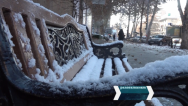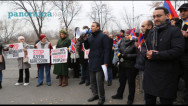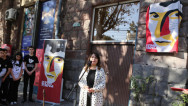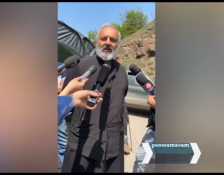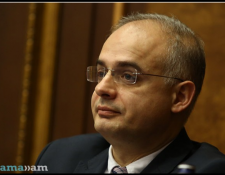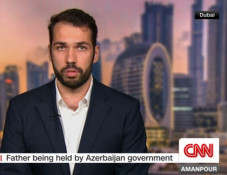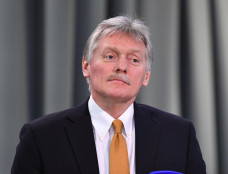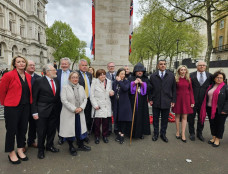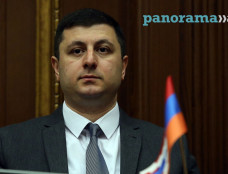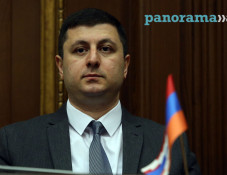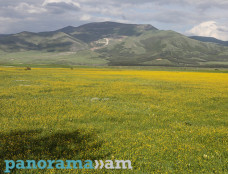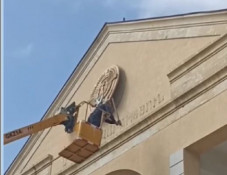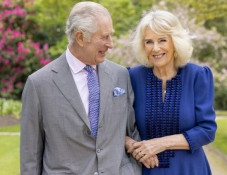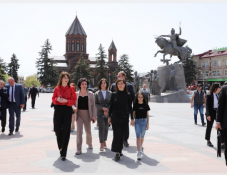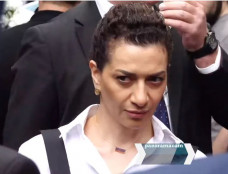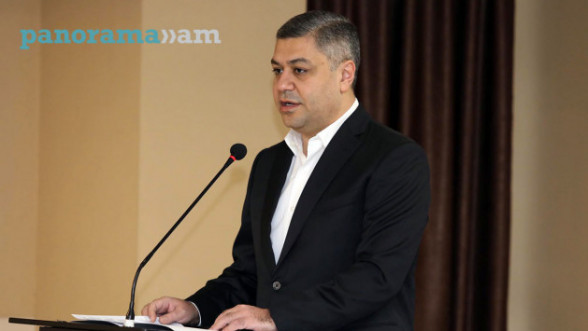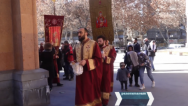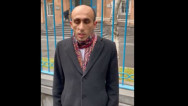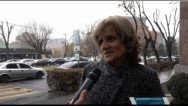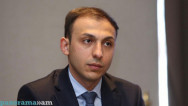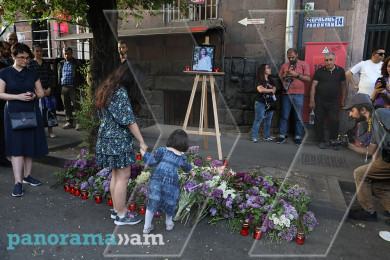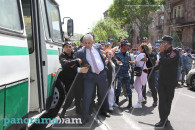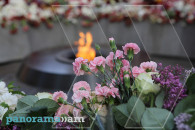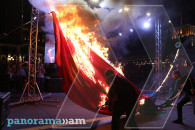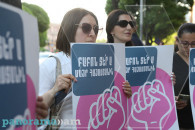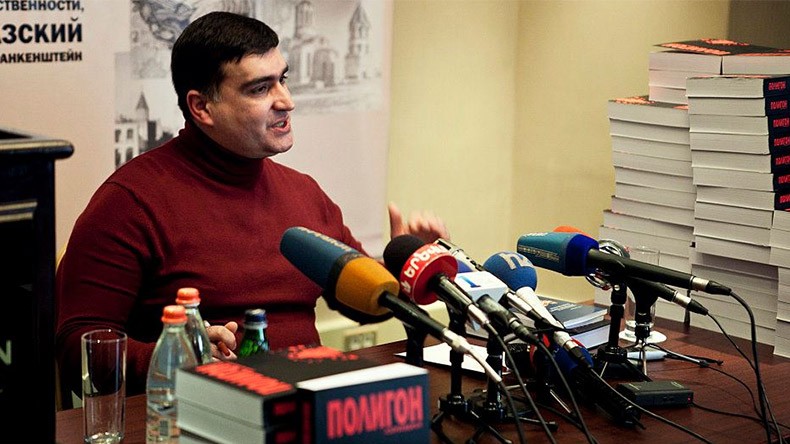
Aris Ghazinyan: Territory of Yerevan generates unlimited time in its limited borders
A tuff stele established on the stylobate of a five-step pyramidal pedestal and considered one of the earlier Christian constructions remaining within Yerevan boundaries rises in the suburb Avan of the capital for already one and a half thousand years. Armenian journalist and researcher Aris Ghazinyan writes about it in his book “Yerevan: with a cross or on the cross,” which is an attempt of setting and considering an extremely diverse range of processes directly or indirectly forming the character of the development of the territory in question and predetermining the inevitability of turning Yerevan into the main center of the Eastern Armenia, and later on into the capital of the recovered Armenian state.
He writes that the territory of Yerevan is a region allowing to trace the process of adaptation of the earliest forms of memorial architecture to the canons of the new religion on the example of the early Christian headstones. The combination of symmetrical step-like pyramids and fan-shaped layers in the territory of Yerevan has been famous since ancient times: this composition has its own place on paintings of temple constructions of Erebuni fortress, dated back in the first half of I millennium BC.
The subsequent process of transposition of ancient eastern religious-memorial forms to Christian principles is also traced in Yerevan boundaries. Therefore, earlier Christian columns of Yerevan are a rare synthesis of traditions and, at the same time, an evidence of the succession of cultural values even in the era of radical changes, the author mentions, stating that the territory of Yerevan generates an unlimited time in its limited borders.
The area located on several cultural layers boiled in the copper of regional wars for centuries, it was an arena of fierce battles for centuries, and that is why it was reconstructed for centuries. Accordingly, the architecture of Yerevan developed not so much in breadth, as in depth: new constructions were built not on the perimeter of older ones, but on their destroyed place, Ghazinyan writes.
Among other factors causing the aforementioned direction of the development of the architecture of Yerevan, the author points out frequent earthquakes, ethno-religious oppressions for a total of ten centuries, a special demographic policy carried out by Muslim metropolitan countries focused on the outflow of the Armenian population and its replacement with Muslims. According to Ghazinyan, all these processes were also accompanied by the demolition of earlier constructions, which were restored only in several years at best. In particular, he mentions that in different historical periods, the territory of the city was included in fifteen very different countries, each of which carried out its own ideological reconstruction towards the given area.
“A remarkable example of the given fact is the territory in the central part of the Armenian capital, where ‘Moscow’ cinema is situated now. In the beginning of 1930s, the Bolshevik government made a decision on the demolition of Saint Poghos and Petros (Paul and Peter) Church of Yerevan located in this area. The church was restored and changed its shape more than once. The earthquake of 1679 destroyed the older temple, and a new one was built in its place on the boundary of XVII-XVIII centuries. In the process of the abolition of the monument, another cultural layer related to the dome construction of X-XI centuries came to the surface. Later the smoothly laid out layer also opened, and it was the base of Yerevan basilica of V century,” the author writes.
When restorers cleaned off the upper layer of the wall-paintings of the church by the initiative of architect A. Tamanyan, then head of the Committee for monument protection, and archeologist A. Kalantar, the secretary of the committee, the original painting of one and a half thousand years belonging to the time of construction of early Christian basilica was discovered; it was a wide frieze occupying the upper part of stone columns with a pattern of bushes and flowers. Below, there was a clean white background, and a picturesque belt started at the level of the human height, consisting of palm trees, cypresses, and flowers.
A prominent specialist of medieval religious fine arts Lydia Durnovo found a similarity between the style of rich ornamental carving of the stone adorning the Hellenistic temple of Garni and the rich ornamental wall-painting of Yerevan basilica. Therefore, it was about Yerevan religious construction of early Christian period, and it was not the only case, Ghazinyan writes.
As for Jrvezh church located 5 kilometers away from Avan temple, Nikolay Tokarski writes that its characteristic features let us date this valuable monument back to the early period of church construction in Armenia, more accurately, to V century.
“The aforementioned facts confirm that life in Yerevan and in adjoining territories has never faded, thereafter, there is no ground to speak about the extinction of life in Yerevan ‘in the protohistory period’,” Ghazinyan highlights.
He writes that in 387 – more than eighty years after the declaration of Christianity as the official religion in the Kingdom of Armenia – the territory of the state was divided between the Eastern Roman Empire (Byzantine) and the Sasanian Empire of Persia. As a result of this division, the western part of Armenia was involved in the orbit of the Greek world, and the eastern lands of Armenia were under the strongest influence of Persia, which supposed bringing the Armenians back to Zoroastrianism. “Twenty years before the division of the country, the Armenian clergy under the leadership of first hierarch Nerses I decided to demolish the Zoroastrian pagan temples and schools of Persian magi, prohibited matrimonies among close relatives, also prohibited burying the dead according to pagan traditions (with hysterics and screaming, tearing clothes; Orthodoxy believed in life after death), and now the situation could change completely,” the author writes.
In 591, three interconnected events took place determining the logics of the further development of the city. “First, Byzantine Emperor Maurice, with the aim of submission of the Armenian Apostolic Church, demanded from Armenian pastor Movses II to unconditionally recognize the decisions of the Council of Chalcedon, but met the sharp rejection of the latter. Then the second division of Armenia took place: according to the agreement signed between Maurice and Sasanian shahanshah Khosrow II Parvez, a part of the territory of Yerevan was given to Byzantine. Eventually, at that time, apologist of Chalcedon resolutions Hovhannes (Hovnan) Bagarantsi was imposed as the Catholicos of Byzantine Armenia, and under his leadership the anti-patronal Catholicate of Avan was founded in Yerevan suburbs,” Ghazinyan writes. Accordingly, the main ideological outpost of the Byzantine influence in Armenia was within the boundaries of the modern Armenian capital and was called to resist the power of the heads of the Armenian Apostolic Church Movses II and his successor Abraham I, whose residence was situated 30 kilometers to the south, in the Persian part of Ararat plain, in the former capital city Dvin.
Ghazinyan cites the bishop and chronicler of VII century Sebeos, according to whom, “Maurice issued a new command – to propagate the Council of Chalcedon in all Armenian churches and give out communions to Armenians along with their troops. But the faithful sons of the Armenian Church escaped to foreign countries and wandered there. Many of them stayed in their places without honoring the king’s command; others incited by ambition joined them in their faith. Then the patriarchal throne was also divided into two parts: the name of one of the patriarchs is Moses (Movses), and the other’s is John (Hovhannes). Moses is from the Persian part, and John – from the Greek part.”
This is how the Armenian Catholicos and historian Hovhannes VI Draskhanakertsi describes the situation: “After this, at the order of the Emperor Maurice they set up a certain Yovhan, who was from the village of Bagaran in the district of Kog, as katholikos of the Greek section [of Armenia] and made him reside in the komopolis of Awan. There Yovhan built a holy church with a superb structure and around it he established his residence. But the great patriarch Abraham, as it was previously mentioned, lived in the city of Dvin which was located in the Persian section, since the river Azat set the borderline between the two sides. Although Yovhan was an upright man, righteous and virtuous in his ways, and had never gone astray after the Chalcedonian heresy,* yet, since he was an anti-katholikos, the homogeneous unity of the patriarchal see was split into two parts and subsequently both sides experienced excessive adversities.”
The residence of Hovnan Bagarantsi – the first and last patriarch of the Armenian Byzantine Church – could not resist the 1679 catastrophic earthquake in Garni, like many other constructions in Yerevan. “But even in ruins, the temple of Avan is a demonstration of the genius of the Armenian architectural thought,” Ghazinyan writes.
The author writes that at the boundary of VI and VII centuries, the territory of Yerevan balanced on the borderline of two worlds, and unlike other regions of Armenia, was not unambiguously “western” (Byzantine) or unambiguously “eastern” (Persian). The border between the split parts passed along Hrazdan and Azat rivers.
The change of the authorities in Constantinople predetermined the inevitability of a war between Byzantine and Persia, as a result of which the Catholicate of Avan was abolished in the suburbs of Yerevan; in 602, the magnificent temple was given to the Armenian Apostolic Church, and Hovnan Bagarantsi escaped.
“Yerevan, which at the boundary of VI and VII centuries was located directly on the borderline of Byzantine and Persia, was a theatre of a fierce uncompromising battle, capable of provoking inner split,” Ghazinyan informs.
The situation, which developed during the first years of the war between Byzantine and Persia, allowed Abraham I to convene a council in Dvin in 609 in order to clear the prospects of the development of Armenian eparchies. The council separated the Georgian Church from the Armenian one, and handed the letter of Catholicos to Kyrion anathema prohibiting any intercourse of the Armenians, followers of pre-Chalcedonian dogmas, with the Chalcedonians.
“The council of Dvin is also famous for the fact that ‘The book of letters’ also names delegates from Yerevan, priors David and Jajik, among its participants. After a ‘thousand-year oblivion’, this is the first text in which the name of the modern Armenian capital emerges,” the author mentions. Therefore, Ghazinyan writes that after many centuries of oblivion, the beginning of VII century, among other events, was also marked by a reference about Yerevan, and since this very time, the name of the city begins to appear in the Armenian chronicle more frequently.
To be continued.
Aris Ghazinyan’s “Yerevan: with a cross or on the cross” is a book about the social and political history of Yerevan and Yerevan district (as a habitat) since the declaration of Christianity to the beginning of XIX century. In addition to demonstrating historical facts based on archive documents and sources, the book also considers the fundamental theses of the Azerbaijani historiography and Pan-Turkic ideology aimed at appropriating the historical, cultural, and spiritual heritage of the Armenians and other nations of the region by falsifying their history.
Related news
- Aris Ghazinyan: According to orientalist Diakonoff's memories, most of Azerbaijani historians had “quite indirect relation” to science
- Aris Ghazinyan: Politicians and scientists in Turkey and Azerbaijan completely ignore primary sources on Yerevan history
- Aris Ghazinyan: Past and future in Azerbaijan are modeled upon decrees and program speeches of president
- ‘Polygon Azerbaijan’: Azerbaijan’s true history ‘in context of global political processes’
Newsfeed
Videos


